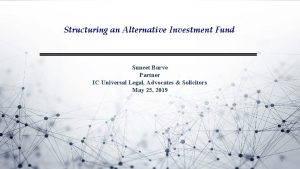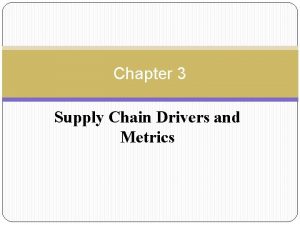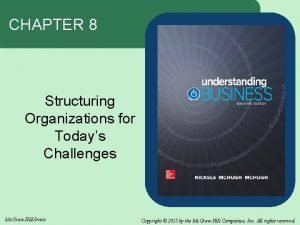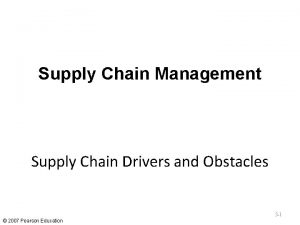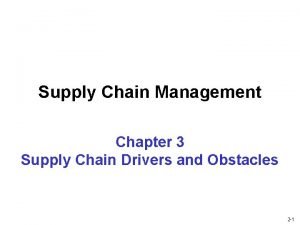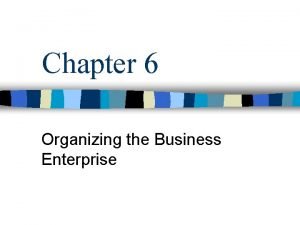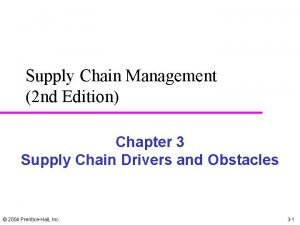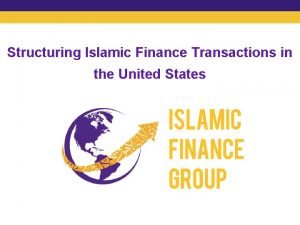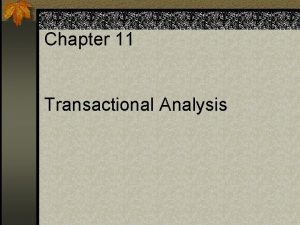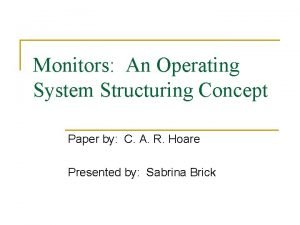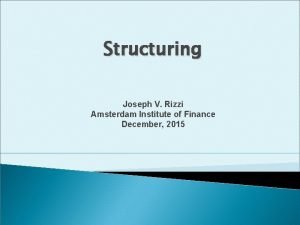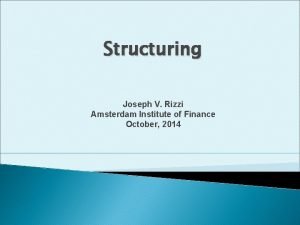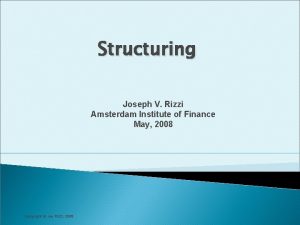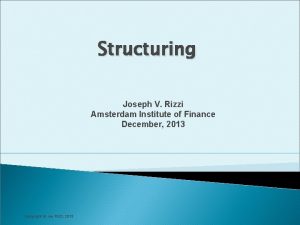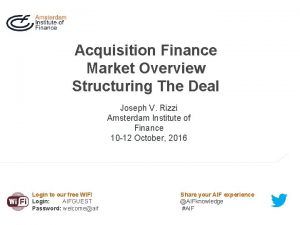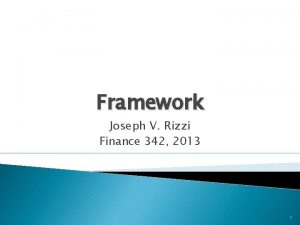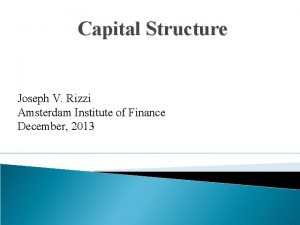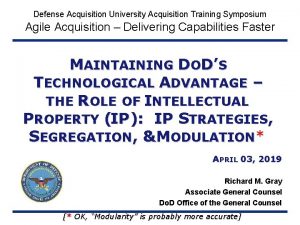Acquisition Finance Structuring The Deal Joseph V Rizzi

































- Slides: 33

Acquisition Finance Structuring The Deal Joseph V. Rizzi Amsterdam Institute of Finance 10 -12 October, 2016 Login to our free WIFI Login: AIFGUEST Password: welcome@aif Share your AIF experience @AIFknowledge #AIF

Structuring Joseph V. Rizzi Amsterdam Institute of Finance October, 2016

M&A Process M&A Strategy • Translate General Strategy into M&A Strategy • Determine Screening Criteria • Identify Targets • Screen/Prioritize • Output: Target with Investment Thesis (Business Case) • Outcome: Go forward decision • Next Step: Contact Target Amsterdam Institute of Finance October, 2016 Deal Phase • Valuation (synergies, sensitivity analysis, walk-away price) • Due Diligence • Deal Structure • Negotiation • Pro forma business model • Integration Planning (degree/scope of integration, etc. ) • Output: Due Dili Report; Full/Final Business case including Final Financials • Outcome: Go/No Go Decision; Close the Deal Integration/ Execution • Leadership • PMI Project Office/Team • 100 Day Plan • Communication Plan • Operating Integration • Customer Integration • Cultural Integration • Performance & Synergy Tracking • Fix/Adjust Process • Post Closing Evaluation • Outcome: Accomplish Investment Thesis 3

Issues in Structuring a Deal Goal of deal structure should be to maximize value – but different parties have different objectives. Some Buyer Shareholder Objectives: - Minimize after-tax price paid for the acquisition - Minimize the dilution of their pre-merger ownership stake - Protect deal Some Seller Shareholder Objectives: - Maximize after-tax price received - Minimize risk of the offer (for a given dollar value of the deal) e. g. termination and go shop Amsterdam Institute of Finance October, 2016 4

Conflicting Agendas for Sellers and Buyers Taking a comprehensive view of the operational and market pressures faced by both parties in the transaction helps to balance conflicting agendas and improve the odds of successful deal execution Buyer Seller Maximize Value § § Create competitive environment among bidders Avoid surprises from bidders’ diligence Control information release Balance length of process against stakeholder expectations Lower. Price Lower Common Goals §Preserve value §Reduce uncertainty §Create efficient tax structure §Minimize distractions §Maintain credibility §Enhance reputation § Limit warranties and indemnifications §Highlight liabilities and risks §Challenge run rates and forecasts §Understand sustainability §Develop advantage over other bidders §Analyze costs and synergies in detail §Maximize warranties and indemnifications §Balance exclusivity and break-frees §Separate smoothly §Minimize post-closing disputes Amsterdam Institute of Finance October, 2016 5

Documents Acquisition NDA LOI Offering Memorandum SPA Financing Bank Book Term Sheet Commitment Letter Fee Letter Credit Agreement(s) Intercreditor Agreement(s) Security Document Amsterdam Institute of Finance October, 2016 6

Deal Terms Price Form of Transaction Form of Payment Control and Governance Social Issues Timing and Deadlines Transaction Hedges Amsterdam Institute of Finance October, 2016 7

Transaction and Structuring Overview Creditors Rights Regulatory and Antitrust Contract Structuring Environment Business Plan Market Conditions Deal Accounting Transaction Characteristics Securities Financial Preferences Corporate Law Tax Competing Bidders Amsterdam Institute of Finance October, 2016 8

Summary of Complicating Factors Competing Bids Size Financial Strength Dilution Analysis Strategic Fit Tax Capital Gains to Seller WHT on divs and int Basis NOL’s Interest deductibility Tax treaties Consolidation Exit planning Rating Agencies Regulatory Amsterdam Institute of Finance October, 2016 Contract Form Consideration Pricing Conditions Repos and Warranties Indemnities Change of Control Covenants Securities Notice S/H Vote Tenders Preemption Rights Triggers Bankruptcy Framework (Inter-creditor Concerns) Subordination Guarantees Corporate Notice Percent by Region/State Lock-Up/Break Up Fee/No Shop Pills/Defenses Merger/Consolidation Antitrust Hart/Scott/Rodino Sherman Act HHI European Commission Monopolies & Mergers Commission Accounting Goodwill Fair Market Value Net Worth Consolidation 9

How Do I Pay: Cash, Stock or Combination Buyer Issues Share Valuation: avoid using undervalued shares Synergy Risk: use cash if synergy risk low to retain upside Market Risk: who bears risk of shares charging price post offer/pre close Fixed price: seller assumes risk Fixed share: buyer assumes risk Collars/caps: share Dilution Earnings Book value Ownership Taxes Asset write-up Tax domicile Credit Ratings Seller Issues Valuation: Taxes: Liquidity: Amsterdam Institute of Finance October, 2016 DD on buyer defer seller capital gains taxes share float, lock-ups and Regulation Rights 10

Forward/Reverse Triangular Mergers Issues: tax, accounting Forward: Target merges into buyer’s wholly owned subsidiary with subsidiary as Continuing entity Pre transaction Post close Buyer Subsidiary Target Subsidiary (including old target) Reverse: Target merges into buyer’s wholly owned subsidiary with target as continuing entity. Subsidiary shares converted into target shares; shares converted into buyer shares Pre transaction Post close Buyer Subsidiary Amsterdam Institute of Finance October, 2016 Target (including subsidiary) 11

Negotiated Cash Merger Timeline HSR Review Period (30 Calendar Days) Pre-Commencement Day 1 Calendar Period (1 Week) Week 2 Day 10 Day 20 Day 30 Day 40 • Engage Investment Bankers • Prepare Merger Agreement, Stockholders Agreement & HSR Premerger Notification • Due Diligence • Fairness Opinion Issued and Boards Approve Merger Agreement • Arrange Financing • Determine Structure (Tax, Accounting, Form, Consideration) Amsterdam Institute of Finance October, 2016 • Sign Merger Agreement & Stockholders Agreement • File HSR Premerger Notification • Commence Preparation of Preliminary Proxy Materials (Schedule 14 A) • Issue Press Release • File 8 Ks and Schedules 13 D • File Preliminary Proxy Materials (Schedule 14 D) with SEC • Print and Mail Proxy Materials To Target Stockholders (Assumes Definitive Proxy Materials Are Available) • HSR Waiting Period Expires, Assuming No Second Request • Target Stockholder Meeting Week 7 • Close Merger 12

Critical Path & Decision Framework Bank Financing Acquisition Bridge Takedown Determine Capital Structure Hedge No Action Financial Flexibility Target Credit Rating Advisory / Origination Amsterdam Institute of Finance October, 2016 Credit Rating Floating. Rate Asset Carveout Securitization Prop Co Fixed- Refinance Bridge Bank Funding Rate Fixed Income Equity / Near Equity Underwriting Product Execution 13

Mechanics Purchase/Sale • Nondisclosure Agreement • Offering Memorandum • Data Room • Letter of Intent • Sale and Purchase Agreement Financing • Commitment Letter(s) • Term Sheet • Credit Agreements • Intercreditor Agreements Amsterdam Institute of Finance October, 2016 14

Structuring Perspectives Business Legal Entity Basis Bankruptcy Payment Priorities Provisions Reps/Warranties: What are the facts? Operating Covenants: Pre Close Financial Covenants: Preserve deal Remedies Structures to reduce credit risk Guarantees Indemnities Pledges of Stock Subordination Deposits / Escrows Amsterdam Institute of Finance October, 2016 15

Acquisition Agreement (Sale & Purchase Agreement) Parties Definitions Form: Merger, Tender, Asset Sale, … Consideration: Type, Payment, Mechanics, Calculation, … Reps/Warranties: Duration, Survival Target: MAC Buyer: Issue when stock used Ordinary Course Covenants: Target will operate as usual during signing/closing gap period Other Agreements: Filings, Meetings, … Closing Conditions: Regulatory, Shareholder Termination & Expenses: Drop Dead Fee, Drop Dead Date, Termination Fees Other Stuff: Choice of Law, Specific Performance Amsterdam Institute of Finance October, 2016 16

Legal Issues Involved in Financing the Transaction Commitment Letters MAC Due Diligence Syndication Flex Marketing Periods Fraudulent Conveyance Loan Documentation Intercreditor Covenants Conditions See: lma. eu. com/documents for drafts Amsterdam Institute of Finance October, 2016 17

Creating the Capital Structure Rule of Thumb Measures ◦ Balance Sheet Model ◦ Cash Flow Model Detailed Model ◦ Matching markets to the need ◦ Reverse inquiry ◦ Projections (amortization capability) Amsterdam Institute of Finance October, 2016 18

Deal Financial Arithmetic Amsterdam Institute of Finance October, 2016 19

Financing Need As a Starting Point Purchase Price + Expenses ◦ Minimum/Maximum ◦ Recapitalization Dividend Debt Refinancing ◦ Callability ◦ Premiums ◦ Tax Issues Expenses Other Uses Amsterdam Institute of Finance October, 2016 20

Structuring Framework Senior Secured First Lien Revolver o o Tied to advance against current assets Crossing liens o o Macro: Ratio of 3 -4 x EBITDA Micro: Amortization analysis tied to cash flow in years 1 -7 o o Senior debt ratio less Term Loan A amortization 1% P. A. /Balloon Term Loan A Term Loan B Second Lien o Macro: 0. 5 -1 x EBITDA o Limited amortization o Longer term Senior/Subordinated Unsecured Other Debt o Total Debt/EBITDA less Senior Debt/EBITDA Equity o Funding need less Total Debt/EBITDA Amsterdam Institute of Finance October, 2016 21

Sizing the Revolver Current Asset approach ◦ Use standard advance rates Accounts Receivable Inventory PP&E/Net 80% 60% 40% ◦ Consider the following factors Seasonal Needs Future Working Capital Growth Unexpected Liquidity Needs Amsterdam Institute of Finance October, 2016 22

Sizing the Term Loans = Maximum Senior Debt - Revolver Focus is on Free Operating Cash Flow Market conditions also dictate the maximum tenor of the loan and the amount required to be amortized Acceptable asset coverage is also a consideration in determining the size of the term loans Amsterdam Institute of Finance October, 2016 23

Add-On Term Loans Typical bank financings as structured as follows: Revolving Credit Term Loan A (amortising) Term Loans B & C (bullet/balloon) • T/LC Rare Large unfunded revolvers are seldom used today due to the fact that it is capital unfriendly to banks and companies don’t like to pay for unused commitments. In the interest of keeping flexibility for the long term, additional indebtedness baskets should be negotiated upfront. This allows companies to access either the bank or bond markets under their existing credit agreements and saves the costs of having to refinance. Amsterdam Institute of Finance October, 2016 24

Junior Capital Long Term Debt = Max Total Debt - Max Senior Secured Debt ◦ Senior unsecured ◦ Sub Debt ◦ Other – unitranche, PIK, … Equity: ◦ Equity = Total Uses - Max Total Debt ◦ Common ◦ Hybrids v Convertibles v Preferred Amsterdam Institute of Finance October, 2016 25

Dell – EMC: Study in Structuring § Largest LBO and Largest Tech M&A at $67 B Equity Provided by Michael Dell, Silver Lake and Temasek § PPX: 67 B/6. 3 = 10. 6 x § Financing SOURCES Tracking Stock USES 18 B (Seller Finance? ) Debt 4. 5 – 50 B New Equity 4 B Excess Cash TBD (3 -21 B) 75 B § Equity + Fees Refinance 67 B 8 B _____ 75 B Debt: FD/EBITDA – 5. 7 x Bank Revolver T/L 10 3 Investment Grade 17 HYB 10 Other 8 48 B Amsterdam Institute of Finance October, 2016 26

Subordination Senior lenders are concerned with the implications of having high yield investors at the table during a restructuring. EURO High Yield investors to date have not been as vocal as senior bank lenders, viewing the issue as one of pricing rather than principle. All other things being equal, sophisticated investors will probably price structural subordination at premium. Amsterdam Institute of Finance October, 2016 27

Contractual Subordination U. S. High Yield Bonds Holding Company 100% Equity Interest s ue Issues Intermediate Holding Company Operating Company Amsterdam Institute of Finance October, 2016 Operating Company Subordination Agreement To what restructuring Senior Secured Loan Guarantees Operating Company Cash Assets 28

Structural Subordination Issues Holding Company High Yield Bonds 100% Equity Interest Issues Intermediate Holding Company Senior Secured Loan Support Package Operating Company Amsterdam Institute of Finance October, 2016 Operating Company 29

Structuring Covenants – Preserving the deal or – I love you just the way you are! Ø Ø Ø There are no standard covenants. They must be tailored to fit each deal and loan structure. The steps in structuring the covenants are: o Identify the risks (business, financial and structural) o Select Covenants to monitor the risks • Need to prioritize the risks to monitor because it will be impossible to monitor every risk • The time and cost to monitor the covenants must be considered (i. e. , sometimes one covenant can cover multiple risks) o Set Appropriate Levels • Want the covenants to trigger a warning before any principal or interest payments become delinquent. Need to factor in any seasonal needs to the covenant levels. Amsterdam Institute of Finance October, 2016 30

Excess Cash Flow Sweep Definition: Portion (usually 50%) of surplus cash (defined term) used to prepay loan facilities Use: 55% of Transactions Amsterdam Institute of Finance October, 2016 31

Financial Covenants as Endangered Species Maintenance v Occurance Major Covenants (financial maintenance) – Industry Variation CAPEX Debt Service Fixed Charge Funded Debt Net Worth Earnings note – currently one or two financial covenants (f. D/EBITDA, EBITDA/I) Reason for Decline Institutional Loan Investors High Yield Market Competition Amsterdam Institute of Finance October, 2016 32

Integration Strategy Must Match Deal Thesis/Strategy Most acquirers fail to consider how deal type impacts what you integrate and how you handle people issues “Scale” deals “Scope” deals Degree of Integration: • Integrate comprehensively • Ensure Integration approach is coordinated across regions • Integrate selectively, only where there is overlap • Ensure business models align and cross-fertilize strengths Organization Structure: • Blend structures; assimilate where the target is small or under-performing • Make decisions early, but don’t sacrifice more informed decisions for speed • Keep organizations separate; blend structures where there is overlap • Define the role of the center and regional/ functional superstructure • Make decisions as early as possible Executive Selection: • Select a small proportion of the target’s executives; select more where the target is larger or better performing • Make decisions early; ideally before announcement • Retain a high proportion of the target’s executives • Make decisions before announcement • Make retention a priority and offer retention incentives Employee Retention: • Target early talent critical to the transition/integration • Target early talent critical to success of company Cultural Integration: • Integrate the two cultures, typically by selecting the “best of both” • Win the hearts and minds of both companies’ employees • Preserve the two cultures • Harmonize at the leadership level (clarify “way of working” and how decisions are made) Amsterdam Institute of Finance October, 2016 33
 Reverse triangular merger
Reverse triangular merger Kelly rizzi
Kelly rizzi Rudolf vizental
Rudolf vizental Deal or no deal machine
Deal or no deal machine Comprehensible input
Comprehensible input Structuring arguments
Structuring arguments Structuring
Structuring Dominance structuring examples
Dominance structuring examples Suneet barve
Suneet barve Supply chain drivers definition
Supply chain drivers definition Structuring element dapat berukuran
Structuring element dapat berukuran Structuring organizations for today's challenges
Structuring organizations for today's challenges International tax structuring
International tax structuring Framework for structuring drivers
Framework for structuring drivers Structuring element
Structuring element Framework for structuring drivers
Framework for structuring drivers Time structuring in transactional analysis
Time structuring in transactional analysis Structuring element dapat berukuran
Structuring element dapat berukuran Organizational structuring
Organizational structuring Framework for structuring drivers
Framework for structuring drivers Thinning and thickening in image processing
Thinning and thickening in image processing Smart structuring
Smart structuring Islamic structuring
Islamic structuring Time structuring in transactional analysis
Time structuring in transactional analysis Requirements structuring
Requirements structuring Morfologi citra
Morfologi citra Span of control in organizational structure
Span of control in organizational structure Monitors: an operating system structuring concept
Monitors: an operating system structuring concept Time structuring in transactional analysis
Time structuring in transactional analysis Political risk structuring solutions
Political risk structuring solutions Stage one relationship building goals
Stage one relationship building goals Direct indirect observation
Direct indirect observation Lời thề hippocrates
Lời thề hippocrates Vẽ hình chiếu đứng bằng cạnh của vật thể
Vẽ hình chiếu đứng bằng cạnh của vật thể








